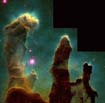
| Bad Astronomy |
|
|
|
BA Blog
|
|
Q & BA
|
|
Bulletin Board
|
| Media |
|
|
|
Bitesize Astronomy
|
|
Bad Astro Store
|
|
Mad Science
|
|
Fun Stuff
|
| Site Info |
|
|
|
Links
|
| RELATED SITES |
| - Universe Today |
| - APOD |
| - The Nine Planets |
| - Mystery Investigators |
| - Slacker Astronomy |
| - Skepticality |
Buy My Stuff

Keep Bad Astronomy close to your heart, and help make me
filthy rich. Hey, it's either this or one of those really
irritating PayPal donation buttons here.
Hubble's Next Next Generation
Week of May 24, 1999 If you've spent a few minutes going through some older Snacks, you'll see that I like using the Hubble Space Telescope (HST). Outfitted with many different types of cameras, HST has capabilities that allow it to view the heavens in ultraviolet, optical and infrared light. Since it is in low Earth orbit (it's average height above the surface is roughly 500 kilometers, within reach of the Space Shuttle), HST can be periodically upgraded with more current technology, or have ailing and aging parts replaced. In October of 1999, an interim servicing mission will be flown to replace some gyros that have failed; the gyros are critical to point HST with the accuracy needed to provide its amazing data.Most people are not really aware of just what is done to HST to service it. And certainly, most people are unaware of the plans NASA is making, even just before the actual mission. I'd like to take a moment to clue folks in on one such mission, four years before the launch is scheduled. This way, you get a sneak peek at the future of Hubble, and you'll have the inside scoop on the mission. When the time comes, and new, beautiful images come from space, you can yawn loudly and say ``Oh, sure, I was in on this years ago!'' ;-)
In an interesting move to save money, NASA decided to reuse instruments removed from Hubble. Instead of simply letting a camera collect dust, they can strip out the old parts and replace them with new, more state-of-the art parts. That way they don't have to start from scratch with new cameras; they can reuse the frames of the old ones, saving millions (yes, millions) of dollars.
 The first in line for such a refurbishment is the Wide Field Camera 3
(called WF3, pronounced ``Whiff 3''). The Wide Field/Planetary Camera (WFPC)
was on board HST when it launched in 1990, and was replaced with the
WFPC2 in 1994.
The first in line for such a refurbishment is the Wide Field Camera 3
(called WF3, pronounced ``Whiff 3''). The Wide Field/Planetary Camera (WFPC)
was on board HST when it launched in 1990, and was replaced with the
WFPC2 in 1994.
 WFPC2 is the camera that takes images in the
stepladder or stealth bomber shape. After WFPC2 was put on board, the original
WFPC was brought to
Goddard Space Flight Center
near Washington, DC. There, the optics are being stripped out and replaced
with much newer, better parts. In 2003, the Space Shuttle will fly
once more, and an astronaut will remove WFPC2 and replace it
with WFC3. The new camera has a larger field of view and is more
sensitive than the older one, and will no doubt take even more amazing
images.
WFPC2 is the camera that takes images in the
stepladder or stealth bomber shape. After WFPC2 was put on board, the original
WFPC was brought to
Goddard Space Flight Center
near Washington, DC. There, the optics are being stripped out and replaced
with much newer, better parts. In 2003, the Space Shuttle will fly
once more, and an astronaut will remove WFPC2 and replace it
with WFC3. The new camera has a larger field of view and is more
sensitive than the older one, and will no doubt take even more amazing
images.
The Wide Field Camera 3 has an excellent web site with images of the camera itself, a history of the camera, and even a glossary of terms used on the site. I highly recommend it.
On a personal note, I was able to get a close look at the camera recently at Goddard when I was doing some work over in the building in which the camera is being built. It was an amazing thing to see it not more than five meters away, jacked up on a tilted pad so that people in those white clean suits could work on it. Quite a bit of Hubble is sitting in that building (a cooler for NICMOS sits next to WFC3, and new solar panels are stored right up the hall), and if you get the chance to visit Goddard I really suggest you do it!
|
|
| THE PANTRY: ARCHIVE OF BITESIZE SNACKS |
|
|
| Subscribe to the Bad Astronomy Newsletter! |
| Talk about Bad Astronomy on the BA Bulletin Board! |